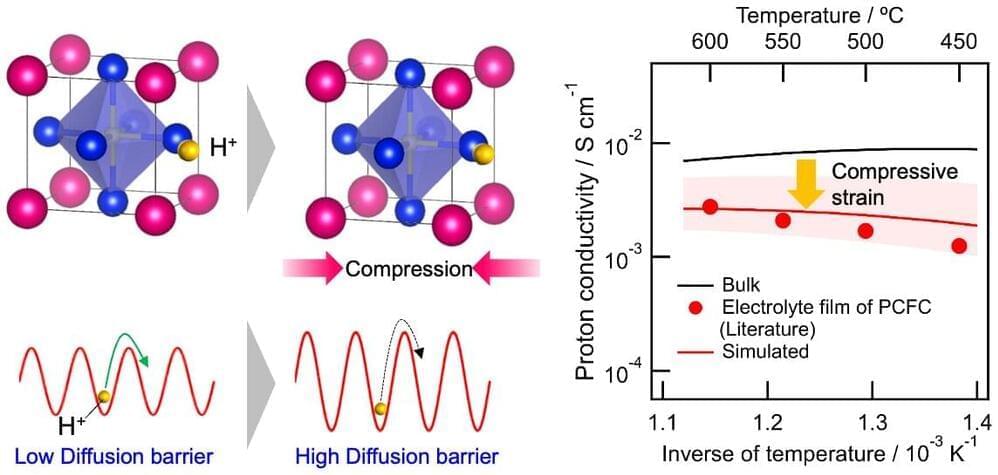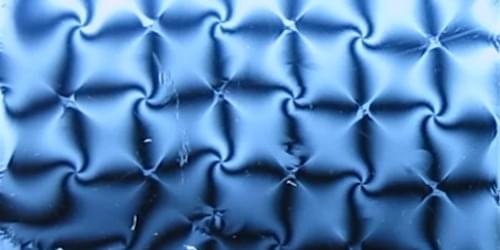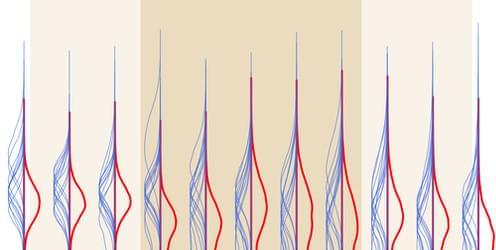The ITRC has received many reports from victims staying their Instagram account was hacked after falling for a bitcoin scam.





Many of us are all too familiar with how strain in work relationships can impact performance, but new research shows that materials in electricity-producing fuel cells may be sensitive to strain on an entirely different level.
Researchers from Kyushu University report that strain caused by just a 2% reduction in the distance between atoms when deposited on a surface leads to a whopping 99.999% decrease in the speed at which the materials conduct hydrogen ions, greatly reducing the performance of solid oxide fuel cells.
Developing methods to reduce this strain will help bring high-performance fuel cells for clean energy production to a wider number of households in the future.

A household microwave oven modified by a Cornell engineering professor is helping to cook up the next generation of cellphones, computers and other electronics after the invention was shown to overcome a major challenge faced by the semiconductor industry.
The research is detailed in a paper published in Applied Physics Letters. The lead author is James Hwang, a research professor in the department of materials science and engineering.
As microchips continue to shrink, silicon must be doped, or mixed, with higher concentrations of phosphorus to produce the desired current. Semiconductor manufacturers are now approaching a critical limit in which heating the highly doped materials using traditional methods no longer produces consistently functional semiconductors.

Black holes are astronomical objects with extremely strong gravitational pulls from which not even light can escape. While the idea of bodies that would trap light has been around since the 18th century, the first direct observation of black holes took place in 2015.
Since then, physicists have conducted countless theoretical and experimental studies aimed at better understanding these fascinating cosmological objects. This had led to many discoveries and theories about the unique characteristics, properties, and dynamics of black holes.
Researchers at Ludwig-Maximilians-Universität and Max-Planck-Institut für Physik have recently carried out a theoretical study exploring the possible existence of vortices in black holes. Their paper, published in Physical Review Letters, shows that black holes should theoretically be able to admit vortex structures.

Liquid crystals are used extensively in flat panel displays, where the light or dark state of each pixel is determined by the orientations of the liquid crystal molecules. Researchers are always looking for new liquid crystal phenomena to exploit, and now a team shows in a series of videos that they can generate traveling waves associated with the rotation of liquid crystal molecules [1]. The experiments demonstrate 3D control over the molecules’ orientations using an applied electric field in only one direction, a level of control that could be useful in future devices.
Jang-Kun Song of Sungkyunkwan University, South Korea, and his colleagues placed a commercial liquid crystal used for displays into the 3.5-micrometer gap between a pair of horizontal glass plates. The team also placed polarizers above and below the plates and oriented the polarizer axes at right angles. This arrangement is opaque when the rod-shaped liquid crystal molecules are oriented vertically or parallel to one of the polarizer axes but transmits light when they are in any other orientation.
The team illuminated the plates from below and filmed the liquid crystal’s response to a voltage applied across the gap. They found that particular repeating voltage patterns—for example, a square wave oscillating between +6 V and −6 V for 10 milliseconds followed by 20 milliseconds with no applied voltage—resulted in light-dark waves moving across the liquid crystal. The researchers varied the parameters for the voltage signal and measured the effects on the wave speed and direction.

With the upgraded detectors at the Laser Interferometer Gravitational-Wave Observatory (LIGO) and its sister facility Virgo, researchers can now measure significantly finer details of the gravitational-wave signals released from black hole mergers. This progress opens tantalizing prospects for black hole spectroscopy, a technique that involves analyzing the signal-frequency spectra of gravitational waves and that could be used to test the limits of the general theory of relativity. In 2019, an analysis of the first detected gravitational-wave signal (GW150914) indicated that it contained multiple tones, or “overtones” (see Synopsis: Hunting for Hair on Coalescing Black Holes), a finding that could lead to novel spectroscopy approaches. Now a new analysis of GW150914 by Roberto Cotesta of Johns Hopkins University in Baltimore and colleagues challenges that previous claim. Cotesta and his colleagues find that the suspected overtones could be caused by noise [1].
The overtones presented in the 2019 study were extracted from the “ringdown” phase of the merger, when the remnant black hole shakes like a struck bell. Cotesta and his colleagues wanted to test whether that 2019 conclusion was robust to the input assumptions used for the extraction. These assumptions include the time at which the gravitational-wave signal peaks and the noise that contributes to the measured signal. The team finds that the procedure is not robust and that some noise patterns—such as fluctuations occurring right around the signal peak—produce artifacts in the data that resemble overtones.
Theoretical physicist Swetha Bhagwat at the University of Birmingham, UK, who wasn’t involved in either study, says that while neither analysis has obvious faults, the fact that slight differences in the parameters used by the two teams lead to opposing conclusions highlights the need for further scrutiny. The detection of overtones has exciting implications for black hole spectroscopy, so it’s very important that the community debates this issue, she says.
The smallest distance in the universe is the unimaginably small Planck length. In this video we will try to imagine it, and explain why it is so significant.
Picture credits.
Fox.
By Xeppo.
https://pixabay.com/photos/mammals-fox-wildlife-natural-wild-3218028/
Kitten.
By Dimhou.
https://pixabay.com/photos/cat-flower-kitten-stone-pet-2536662/
Duckling.
By Alexas_Fotos.
https://pixabay.com/photos/mallard-ducklings-duck-chicks-cute-3524213/
ant.
by Mylene2401
https://pixabay.com/photos/ant-rose-petals-insect-animal-5235935/
Sand.
By PDPics.
https://pixabay.com/photos/sand-granulate-granulate-material-167005/
Statue of liberty.
By Itou365
https://pixabay.com/photos/new-york-statue-of-liberty-115626/
Big ben.
By pdimaria.
https://pixabay.com/photos/westminster-big-ben-london-902972/
– Absolute Hot: What is the hottest temperature possible. Today I’m going to look at the Planck Temperature and it’s about to get very…